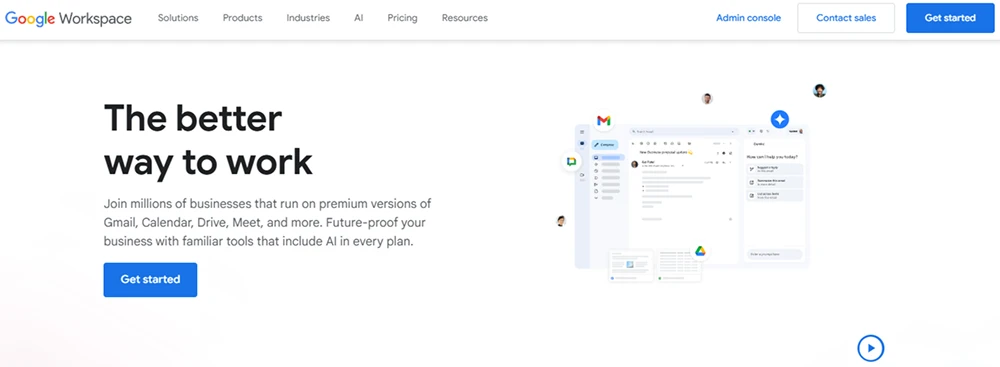Google Workspace Overview & 2026 Industry Position
Google Workspace, formerly G Suite, stands as one of the most robust cloud productivity platforms worldwide. As of 2026, it powers over 5 million businesses and 3 billion users globally. Its suite includes familiar tools like Gmail, Google Drive, Docs, Sheets, Meet, and Calendar—all reimagined for the AI-first era. With generative AI, deeper security controls, and flexible licensing models for hybrid teams, Google Workspace continues to dominate the collaborative SaaS space.
From Launch to 2025: Google Workspace’s Journey
Originally launched as Google Apps for Your Domain in 2006, the platform evolved into G Suite in 2016 before becoming Google Workspace in 2020. Its mission has remained consistent: deliver seamlessly integrated productivity apps with unmatched scalability. Milestones include:
- 2006 – Launch of Google Apps (Gmail, Calendar, Talk, Page Creator, Docs)
- 2012 – Google Drive launched to centralize storage
- 2016 – Rebrand to G Suite with Hangouts Meet and Chat
- 2020 – Google Workspace brand introduced, unifying apps under one UX
- 2023 – Duet AI launched for collaboration and content generation
- 2025 – Gemini AI embedded across Workspace, new smart canvas tools
In 2026, Google Workspace is doubling down on real-time AI collaboration and enterprise-grade security positioning it as the core digital workspace across SMBs and enterprises alike.

Google Workspace Key Features
Google Workspace bundles together a suite of powerful tools optimized for speed, collaboration, and smart suggestions. Standout innovations as of 2026 include:
- Gmail & Chat: AI-suggested replies, tone refinement, and smart summarization
- Docs & Sheets: Embedded Gemini AI for drafting, formula generation, and editing suggestions
- Google Meet: Real-time translation, background noise cancelation, and companion mode enhancements
- Calendar: Smart scheduling across time zones and resource-aware booking
- Vault & Admin: Enhanced compliance, data loss prevention (DLP), and zero-trust access controls
Workflow & UX
Google Workspace’s modern interface remains clean and intuitive. Updates in 2026 include:
- Consistent UI/UX across web/mobile with Material Design 4
- Unified “Smart Canvas” for seamless cross-app collaboration
- Multi-language and real-time co-authoring
- Gemini-powered proactive assistance across apps
- Drag-and-drop integrations with Google Drive and third-party apps
Pro Tip: Use @-mention shortcuts in Docs and Sheets to instantly link people, files, or calendar entries without breaking your workflow.
Google Workspace Pricing Analysis & Value Metrics
As of July 2025, Google Workspace pricing in the U.S. includes the following plans:
| Plan | Monthly (User) | Key Features |
|---|---|---|
| Business Starter | $6 | 30 GB storage, Gmail, Meet (100 users), standard support |
| Business Standard | $12 | 2 TB storage, Meet (150 users + recording), shared drives |
| Business Plus | $18 | 5 TB storage, Vault, advanced security, attendance tracking |
| Enterprise | Custom | Unlimited storage, S/MIME encryption, Gemini AI, enterprise support |
Verdict: Packed with value, particularly at the Standard and Plus tiers. High scalability for businesses of any size.
Competitive Landscape
| Platform | Core Strengths | Pricing | Best For |
|---|---|---|---|
| Google Workspace | AI features, Gmail ecosystem, scalability | $6–$18/mo | Startup to enterprise |
| Microsoft 365 | Offline-first apps, deeper Excel functions, Teams | $6–$22/mo | Large orgs, Windows-heavy |
| Zoho Workplace | Budget flexibility, built-in CRM | $3–$6/mo | SMBs with tight budget |
| Apple iWork | Polished design, iCloud sync | Free | Mac/iOS micro teams |
Use Cases
Google Workspace adapts to diverse business and educational needs:
- Remote Teams – real-time doc editing, Meet with live captions
- Startups – low upfront cost, high scalability
- Education – 1:1 device programs and academic collaboration tools
- Enterprises – advanced compliance, role-based access, SIEM integrations
- Nonprofits – discounted pricing and secure collaboration
Integrations
- CRM: Salesforce, HubSpot
- Project Mgmt: Asana, Trello, Jira
- Finance: QuickBooks, Xero
- HR & Legal: DocuSign, BambooHR
- Security: Okta, Splunk
Over 5,000 third-party connections via Google Workspace Marketplace help tailor workflows to every business scenario.
Pros & Cons of Google Workspace
- Pros:
- Slick UX and quick learning curve
- Advanced AI assistants with Gemini
- Robust mobile experience
- Tight Gmail + Meet integration
- Cons:
- Storage limits in lower tiers
- AI tools locked behind Enterprise
- Less offline capability vs MS Office
Final Thoughts
Whether you’re a freelancer, startup founder, or IT admin for a global enterprise, Google Workspace plans are future-ready and richly featured. Its AI-first focus and seamless cross-app ecosystem make it the top contender in 2026. While Microsoft 365 holds ground for legacy users, Google wins on usability, speed, and integration flexibility.
Google Workspace FAQ
Gmail is part of Google Workspace, but Workspace also includes tools like Docs, Meet, Drive, Sheets, and Admin controls for teams and businesses.
Yes. Google Workspace features zero-trust architecture, two-step authentication, DLP, and compliance options including HIPAA, GDPR, and ISO certifications.
Business Starter includes 30 GB/user storage, doesn’t support shared drives, and lacks advanced admin/security tools found in higher tiers.
Yes, Google offers migration tools for email, calendars, and files. Workspace is highly compatible with legacy Microsoft formats like .docx and .xlsx.
Absolutely. Workspace integrates Gemini AI for drafting emails, summarizing docs, generating Sheets formulas, and enhancing Meet sessions with real-time translation.